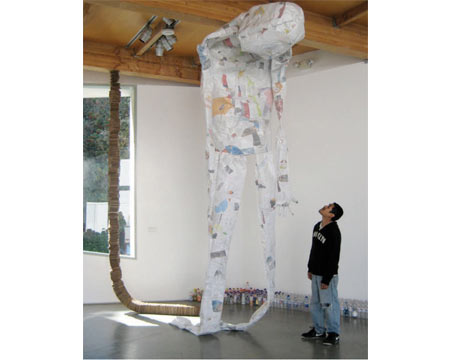
“Kim Abeles: Art and Activism,” while not an official retrospective, encompasses work from 1984 to the present and will offer viewers the widest glimpse of her uniquely investigative oeuvre in well over a decade. The survey, if you dare to narrow it down to categorical description, features work that addresses, in no particular order - feminist, environmental, and socio-political concerns, without being overbearing or leaving a cloying aftertaste that much consciousness-raising art is wont to do. While so-called ‘activist art’ isn’t for everyone, it’s virtually inevitable that amongst Abeles’ array of thoroughly multi-media offerings spanning over three decades, everyone will find something that intrigues. But most works will require a bit of reading, in addition to a little time to explore — Abeles’ projects always include a back-story .
Several of her signature “Smog Catchers” are included, from 1992’s “Presidential Seal in 20 Days of Smog,” a delightfully subversive meditation on power and progress. The selection brings up to 2010’s “Digit Count In Smog and Us,” which maps pollution and breast cancer. Abeles creates images on acrylic, cellulose or porcelain, among other surfaces, by stenciling images on them and allowing the silty downtown air to collect over time on the roof of her studio (it’s a process reminiscent, if only superficially, of fellow Angelino Allison Cortson, who uses dust in her portrait paintings). The smog collection procedure itself is rather poetic: a time-lapse in which the art collaborates with ‘nature’ in a counter-intuitive way, softly reminding us about our chosen environment, and its impact that we’re allegedly acclimatized to. (To be fair though, since the smog collecting takes place over 20-40 days, one may wonder what kind of build-up you’d find on a plate left out in, say, Lake Arrowhead.)
Several pieces from Abeles’ 1987 installation, “The Image of St. Bernadette” showcase her penchant for finely-detailed and visually versatile deconstructions of (in this case, obscure) historical figures. Marie-Bernarde Soubirous was a poor young woman of Lourdes, France, who experienced multiple apparitions of the Virgin Mary at the age of 12 in 1858. She gradually turned the town, and herself, into a pilgrimage destination. Abeles found in this icon a kindred spirit – if you will – to the artist: each were “seen as both visionary and freak.” Using images of the Saint (she was canonized by the Catholic Church in 1933), Abeles transformed Bernadette’s legend into early versions of her concept-based art, which favors the theatrical over the dry. “Traveling Sales” is a gilded-leather suitcase, filled with Bernadette-centric religious souvenirs, that gently melds consumerism with both icon- and hero-worship. The beautifully titled “Willing Suspension of Disbelief” reconfigures Bernadette – based on the most iconic photograph of her – as the multi-patterned dress and accompanying head-scarf, hovering horizontally through a hoop, with the work’s title written in cursive across a wood base. Religion and Duchampian aesthetics never seem to go out of style.
The show’s grandest gesture, certainly the largest, is to be seen in “Paper Person” (2009). A 30-foot long figure made out of waste recycled from the dumpsters at the tony Harvard-Westlake School’s upper school campus, it’s a most zeitgeist-y work. It reminds me of a recent back-page news item about a Long Beach mother who, by way of her initiative, inspired her son’s middle-school to adopt a recycling program where not even a single bin had previously existed. As installed at the school, the towering body floated vertically, its head hanging limply across the ceiling in a posture and bearing not unlike an early Tim Hawkinson figure. The work was part of a larger environmentally-conscious project and installation at the school called “Nature Studies,” and is well-documented on Abeles’ website “Frugalworld.”
The materials that make up “Paper Person” were collected by Abeles in just one day of dumpster-diving. Though an urge to chime “Busted!,” and point fingers at yet another perpetrator of extraneous waste may be thwarted by the fact that Abeles admitted to beating the trash collectors to the garbage’s source (which, also admittedly, was pre-sorted for recycling), such skepticism may be besides the point. In the era of “Go Green – Please don’t print this email,” the only way one might elicit action is by hiding the plea in a Trojan horse. It can be risky business raising this kind of consciousness: viewers shy away from preachiness, if not turn downright contrarian. And you certainly would never want to be caught preaching to the converted. But with Abeles, and “Paper Person” in particular, it can become, if successful (and that depends on the viewer), a source for contemplation, which in turn may allow us to see something anew even if we’ve heard it a thousand times. Just as a few of the Harvard-Westlake students discovered their scrapped homework inadvertently memorialized in the piece, so does Abeles invite us to sift through cultural legacies and ephemera alike, having given them new life.
Published courtesy of ArtSceneCal ©2010
